Development and Prospect of Vacuum High-Pressure Gas Quenching Technology
Abstract
:1. Introduction
2. Development of Vacuum High-Pressure Gas Quenching Technology
2.1. Development of Vacuum High-Pressure Gas Quenching Equipment
2.2. Structure and Working Principle of Vacuum Gas Quenching Resistance Furnace
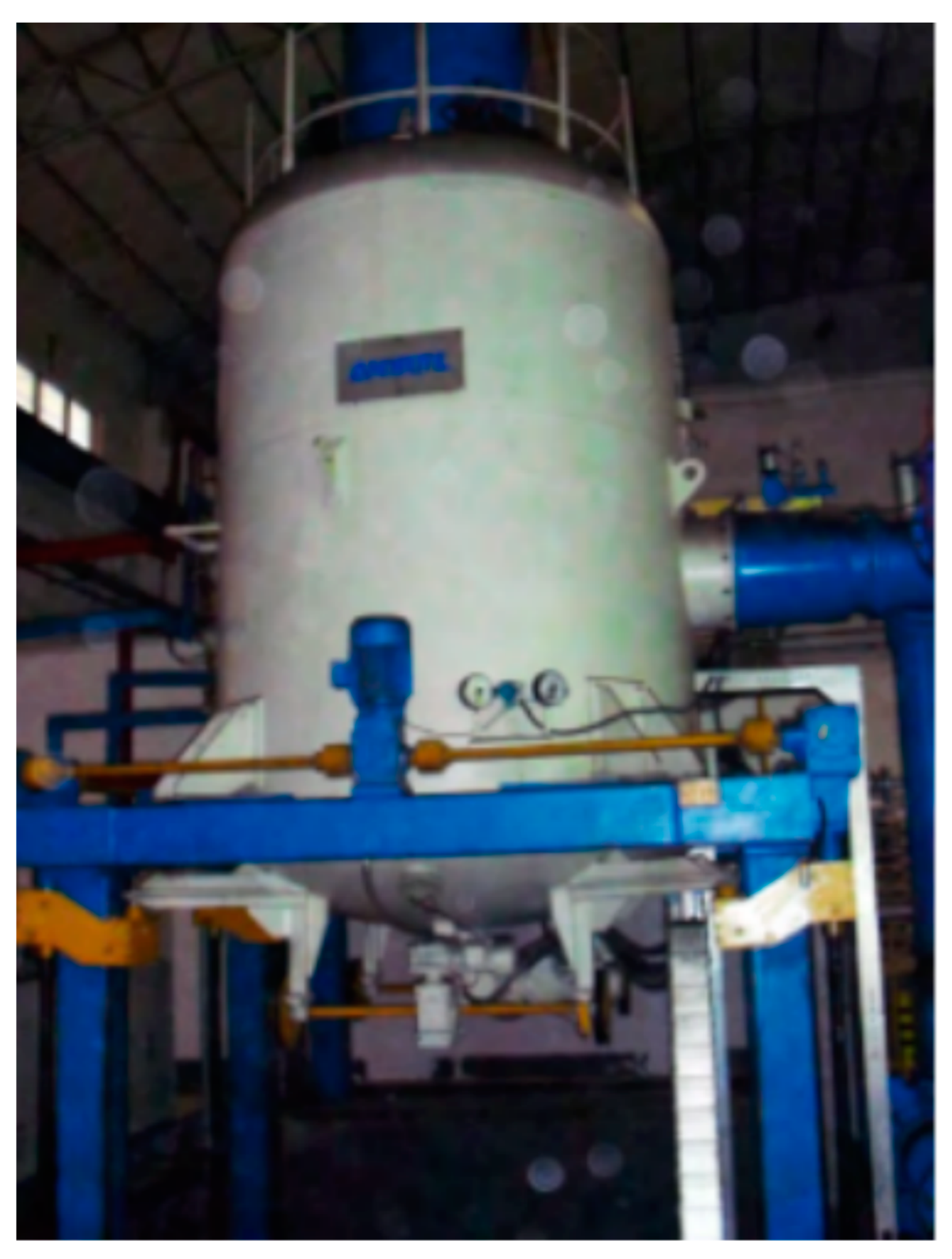
2.3. Development of Vacuum High-Pressure Gas Quenching Technology
3. Experimental Study of Vacuum High-Pressure Gas Quenching and Main Influencing Factors
3.1. Comparison of Vacuum Gas Quenching and Other Quenching Methods
3.2. Essential Factors Affecting Vacuum High-Pressure Gas Quenching
4. Current Situation of Computer Simulation of Vacuum High-Pressure Gas Quenching Process
4.1. Influence of Structure of Gas Quenching Furnace on Gas Quenching
4.2. Simulation of Workpiece Temperature Field and Phase Transition
4.3. Simulation of the Flow Field in Vacuum Furnace
4.4. Simulation of Mechanical Properties of Workpieces
5. Summary
- (1)
- The vacuum gas quenching furnace with high thermal conductivity, low cost, high cooling rate and good safety are expected to be developed to ensure the safe use of hydrogen or mixed gas quenching medium, so as to meet the high efficiency gas quenching requirements of large and complex workpieces.
- (2)
- Precise control of heating and cooling speed to obtain the best microstructure and properties of materials. This can be attained through the integration of an automatic adjustment damper into the cooling path, along with temperature and airflow sensors, all of which are incorporated into a sophisticated control system. With these advanced features, the heating and cooling speed can be precisely calibrated to ensure the desired outcome, allowing for unparalleled control over the material’s microstructure and properties.
- (3)
- Determining the critical diameter of vacuum gas quenching of different steels under different quenching pressures and loading capacities is convenient for process production.
- (4)
- Developing high-precision simulation software for vacuum gas quenching based on specific furnace types can help to meet the requirements of personalized optimal vacuum gas quenching processes with different materials and different loads.
- (5)
- Developing the special furnace for vacuum gas quenching and heat treatment of extremely widely used parts and its auxiliary software system can help to realize the standardized and automatic production of the best effect and the least energy of vacuum gas quenching and heat treatment of parts.
Author Contributions
Funding
Data Availability Statement
Conflicts of Interest
References
- Wu, S.Q. Vacuum High Pressure Gas Quench Heat Treatment. Die Mould Manuf. 2002, 4, 53. [Google Scholar]
- Li, Z.; Grandhi, R.V.; Shivpuri, R. Optimum design of the heat-transfer coefficient during gas quenching using the response surface method. Int. J. Mach. Tools Manuf. 2002, 42, 549–558. [Google Scholar] [CrossRef]
- Wang, Z.J.; Xu, C.H.; Li, F.Z.; Wang, B.X.; Li, M.C.; Hui, Z. Development in technique and equipment of high-pressure gas quenching vacuum furnaces. Vacuum 2002, 6, 14–20. [Google Scholar]
- Zhu, Y.Y. High pressure gas quenching vacuum heat treatment process and equipment at home and abroad. Eng. Des. Appl. Res. 1992, 7, 13–21. [Google Scholar]
- Zhou, H.; Wu, N.; Ma, L. Application of Heat Treatment Vacuum Quenching Process. Hongdu Sci. Technol. 2009, 2, 43–49. [Google Scholar]
- Samuel, A.; Prabhu, K.N. Residual Stress and Distortion during Quench Hardening of Steels: A Review. J. Mater. Eng. Perform. 2022, 31, 5161–5188. [Google Scholar] [CrossRef]
- Yu, L.; Yang, Y. Application status and development direction of vacuum high-pressure gas quenching technology in China. In Proceedings of the 19th Heat Treatment Technology Exchange Conference in North China and the 12th Annual Academic Meeting of Tianjin Heat Treatment Society, Tianjin, China, 1 August 2012. [Google Scholar]
- Pan, Z.; Zhu, Y.X.; Bian, K.Q. Exploration of vacuum gas quenching process. Met. Work. 2019, 5, 18–19. [Google Scholar]
- Shen, Z.X. Vacuum air quenching. Hot Work. Technol. 1984, 4, 55–57. [Google Scholar]
- Zhou, Z.H. Practical application of vacuum heat treatment in 20 cases. Heat Treat. Met. 1988, 1, 41–47. [Google Scholar]
- Gong, X.N.; Liu, Q.; Liu, Z.G.; Bai, Y.S. HPV-200 high-pressure vacuum air quenching furnace equipment and process. Vacuum 1990, 1, 13–19. [Google Scholar]
- Zhang, H.K.; Chen, S.M. Polish high-pressure gas quenching vacuum furnace and domestic auxiliary facilities. Heat Treat. Met. 1993, 6, 29–34. [Google Scholar]
- Fan, D.L.; Tian, R.Z.; Kowalewski, J. New Progress of Vacuum Heat Treatment Technology—High and Superhigh Pressure Gas Quenching. Heat Treat. Met. 1999, 10, 19–21. [Google Scholar]
- Heuer, V.; Loser, K.; Busch, G. Professional heat treatment service for automobile industry. In Proceedings of the 6th China Heat Treatment Week, Beijing, China, 26–29 October 2009. [Google Scholar]
- Zhang, H.K. Progress and Application of Vacuum Air Quenching Furnace. Hot Work. Technol. 1996, 3, 2–5. [Google Scholar]
- Gao, W.; Gao, F.L.; Yang, J.L. Development of a new type of high-pressure vacuum air quenching furnace. Mech. Des. Manuf. 1997, 5, 18–20. [Google Scholar]
- Song, J.L.; Meng, L.; Liu, X.W. Research and Development of HZQL-450 Vertical High Pressure Gas Quenching Vacuum Furnace. In Proceedings of the 50th Anniversary Conference of the National Society for Heat Treatment and the 9th China Heat Treatment Week, Beijing, China, 24–27 September 2013. [Google Scholar]
- Zhang, J.F.; Jin, L.Y.; Cheng, J.P.; Yang, R.H. Development of gas quenching vacuum furnace. Shanxi. Sci. Tech. 2009, 1, 104–105. [Google Scholar]
- Hou, W.Q.; Zhang, J.F. Development of Gas Quenching Vacuum Furnace. Electron. Process Technol. 2008, 4, 227–230. [Google Scholar]
- Ma, W.D. Development of a new horizontal double-chamber vacuum air-cooled oil quenching furnace. In Proceedings of the 7th Quality Work Conference of the Director and Manager Meeting of China Heat Treatment Industry, Beijing, China, 19 September 2006. [Google Scholar]
- Liu, B.Q. Nitrogen doping with dual-vacuum furnace at IHEP. Nucl. Inst. Methods Phys. Res. A 2021, 993, 165080. [Google Scholar] [CrossRef]
- Song, J.L.; Liu, W.Y.; Meng, L.; Liu, X.; Zhao, Y. Development of large vertical high pressure gas quenching vacuum furnace. Met. Work. 2014, 19, 36–38. [Google Scholar] [CrossRef]
- Wang, Q.; Jiang, Z.; Shen, Z.Y.; Lu, J. Improvement on vacuum heat treatment process for die steel. Heat Treat. 2012, 27, 34–37. [Google Scholar]
- Yu, L.; Liu, Q.S.; Yang, Y. A New Type of Fins Heat Exchanger Working for High-pressure Gas Quenching Furnace. Press. Vessel Technol. 2012, 29, 65–68. [Google Scholar]
- Shanghai Automobile Transmission Co., Ltd. Gas Carburizing and Quenching Process for Internal Gear Ring of Transmission: CN102808188B; Shanghai Automobile Transmission Co., Ltd.: Shanghai, China, 2012. [Google Scholar]
- Yu, X.F.; Wang, S.Y.; Wang, Y.P.; Yang, S.; Yang, Y.; Su, Y.; Feng, X. Effect of Vacuum Graded Quenching on Microstructure and Mechanical Properties of 8Cr4Mo4V Steel. Chin. J. Mater. Res. 2022, 36, 443–453. [Google Scholar] [CrossRef]
- Heuer, V.; Faron, D.R.; Bolton, D.; Lifshits, M.; Loeser, K. Distortion Control of Transmission Components by Optimized High Pressure Gas Quenching. J. Mater. Eng. Perform. 2013, 22, 1833–1838. [Google Scholar] [CrossRef]
- Pan, Z. High pressure gas quenching equipment and technology. Heat Treat. Met. 2021, 46, 247–249. [Google Scholar]
- Yu, T.; Tan, Z.L.; Wang, J.; Zhang, M. Realization of quenching & dynamic partitioning on large-size parts. Mater. Manuf. Processes 2022, 37, 1490–1499. [Google Scholar]
- Zhang, W.M. Effect of quenching method on quenching structure and tempering hardness of cold-working die steel SKD11. Heat Treat. Technol. Equip. 2001, 22, 21–22. [Google Scholar] [CrossRef]
- Lin, Z.B. Study on Vacuum Quenching Process of Cr12MoV Steel. Master’s Thesis, Zhongyuan University of Technology, Zhengzhou, China, 2015. [Google Scholar]
- Yu, H.Y.; Zhao, Z.W.; Fan, S.H. Microstructure and hardness of vacuum air quenched high speed steel. Shanghai Met. 1989, 1, 20–24. [Google Scholar]
- Wang, Y.L.; Wang, J. Comparison of Microstructure and Properties of 1Cr17Ni2 Steel between Vacuum Gas Quenching and Conventional Oil Quenching. Hot Work. Technol. 2009, 38, 149–150. [Google Scholar]
- Guanghua, Y.; Xinmin, H.; Yanqing, W.; Xingguo, Q.; Ming, Y.; Zuoming, C.; Kang, J. Effects of Heat Treatment On Mechanical Properties Of H13 Steel. Met. Sci. Heat Treat. 2010, 52, 393–395. [Google Scholar] [CrossRef]
- Zhang, J.G.; Cong, P.W. Vacuum Heat Treatment of Hot-Work Die Steel H13. Heat Treat. Met. 2005, 30, 77–80. [Google Scholar]
- Zhou, A.Q. Effect of Isothermal Spheroidization on Microstructure and Properties of Steel H13. Heat Treat. Met. 2003, 28, 53–58. [Google Scholar]
- Ye, J.; Lu, J.M. Materials for Large-sized Die-Casting Dies and its Vacuum Heat Treatment Technology. Heat Treat. Met. 2003, 28, 53–58. [Google Scholar]
- Syifa, L.; Ahmad, F.; Bambang, S.I. The Effect of Vacuum Quenching on Corrosion and Hardness of the Surface of SKD61 Steel. IOP Conference Series: Materials Science and Engineering; IOP Publishing: Bristol, UK, 2019; Volume 694. [Google Scholar]
- Sola, R.; Giovanardi, R.; Veronesi, P.; Poli, G. Effect of quenching method on the wear and corrosion resistance of stainless steel AISI 420 (TYPE 30Kh13). Met. Sci. Heat Treat. 2013, 54, 644–647. [Google Scholar] [CrossRef]
- Macchion, O.; Zahrai, S.; Bouwman, J.W. Heat transfer from typical loads within gas quenching furnace. J. Mater. Process. Technol. 2006, 172, 356–362. [Google Scholar] [CrossRef]
- Thuvander, A.; Melander, A.; Lind, M.; Lior, N.; Bark, F. Prediction of convective heat transfer coefficients and examination of their effects on distortion of tubes quenched by gas cooling. In Proceedings of the 4th ASM Heat Treatment and Surface Engineering Conference in Europe, Florence, Italy, 19 October 1998. [Google Scholar]
- Igarashi, T. Characteristics of the flow around two circular cylinders arranged in tandem: 1st report. Bull. JSME 1981, 24, 323–331. [Google Scholar] [CrossRef]
- Roshko, A. On the wake and drag of bluff bodies. J. Aeronaut. Sci. 1955, 22, 124–132. [Google Scholar] [CrossRef]
- Roshko, A. Perspectives on bluff body aerodynamics. J. Wind. Eng. Ind. Aerodyn. 1993, 49, 79–100. [Google Scholar] [CrossRef]
- Koenig, K.; Roshko, A. An experimental study of geometrical effects on the drag and flow field of two bluff bodies separated by a gap. J. Fluid Mech. 1985, 156, 167–204. [Google Scholar] [CrossRef]
- Bless, F.; Edenhofer, B. Advances in increasing the quenching speed of single-chamber vacuum furnaces with high-pressure gas-quench systems. Heat Treat. Met. 1997, 4, 89–91. [Google Scholar]
- Pritchard, J.E.; Nurnberg, G.; Shoukri, M. Computer modelling of pressure gas quenching in vacuum furnaces. Heat Treat. Met. 1996, 4, 79–83. [Google Scholar]
- Su, X.W.; Gu, M. Research status and prospects of the numerical simulation of quenching process. Heat Treat. Met. 2008, 33, 1–7. [Google Scholar]
- Kula, P.; Korecki, M.; Pietrasik, R.; Wołowiec, E.; Dybowski, K.; Kołodziejczyk, Ł.; Atraszkiewicz, R.; Krasowski, M. FineCarb—The flexible system for low-pressure carburizing. New options andperformance. Jpn. Soc. Heat Treat. 2009, 49, 133–136. [Google Scholar]
- Dowling, W.; Pattok, T.; Ferguson, B.L. Development of a carburizing and quenching simulation tool: Program overview. HTM J. Heat Treat. Mater. 1997, 1, 1–6. [Google Scholar]
- Pan, J.; Li, Y.; Li, L. The application of computer simulation in the heat-treatment process of a large-scale bearing roller. Mater. Process. Technol. 2002, 122, 241–248. [Google Scholar] [CrossRef]
- Song, R.G.; Zhang, Q.Z. Heat treatment optimization for 7175 aluminum alloy by genetic algorithm. Mater. Sci. Eng. C 2001, 17, 133–137. [Google Scholar] [CrossRef]
- Song, R.G.; Zhang, Q.Z. Heat treatment technique optimization for 7175 aluminium alloy by an artificial network and a genetic algorithm. Mater. Process. Technol. 2001, 117, 84–88. [Google Scholar] [CrossRef]
- Xu, L.; Wang, Z.J. Applicability of the turbulence model in numerical simulation of vacuum gas quenching process. Vacuum 2012, 49, 81–83. [Google Scholar]
- Jin, L.Y.; Wang, C.J. Safety Design and Analysis of Vacuum Gas-quenching Furnace. Equip. Electron. Prod. Manuf. 2012, 41, 53–57. [Google Scholar]
- Wang, Q.; Lu, J.; Sun, W.C.; Shen, Y.W.; Wang, W. Numerical Simulation and Verification of Quenching Processes in Two Types of High Pressure Gas Quenching Vacuum Furnace. Heat Treat. 2014, 29, 51–53. [Google Scholar]
- Kumhar, K.M.; Rahul, B.; Sathyaseelan, S.; Babu, K. Estimation and analysis of surface heat flux during gas quenching through IHC method. Mater. Today Proc. 2023, 72, 2174–2180. [Google Scholar] [CrossRef]
- Wang, T.; Cong, P.W.; Li, Y.; Du, C.H. Application of response surface methodology in structural optimization of gas quenching. Heat Treat. Met. 2018, 43, 203–206. [Google Scholar]
- Xu, Z.X.; Su, X.L.; Xu, Q.Y.; Liu, B.C. Numerical simulation on vacuum solution heat treatment and gas quenching process of a low rhenium-containing Ni-based single crystal turbine blade. China Foundry 2016, 13, 402–413. [Google Scholar] [CrossRef]
- Yuan, K.Y.; Zhou, L.H.; Li, J.W.; Min, Y.M.; Liu, L. Numerical Simulation of Vacuum Gas Quenching Process of Large Aircraft Thin-wall Part. Shanghai Met. 2018, 40, 11–17. [Google Scholar]
- Sugianto, A.; Narazaki, M.; Kogawara, M.; Shirayori, A.; Kim, S.Y.; Kubota, S. Numerical simulation and experimental verification of carburizing-quenching process of SCr420H steel helical gear. J. Mater. Process. Technol. 2009, 7, 3597–3609. [Google Scholar] [CrossRef]
- Cheng, H.M.; Wang, H.G.; Xie, J.B. Calculation of coupled problem between temperature and phase transformation during gas quenching in high pressure. Appl. Math. Mech. Engl. Ed. 2006, 27, 305–311. [Google Scholar] [CrossRef]
- Cheng, H.; Huang, X.; Fan, J.; Wang, H. The application of rational approximation in the calculation of a temperature field with a non-linear surface heat-transfer coefficient during quenching for 42CrMo steel cylinder. Met. Mater. Int. 1999, 5, 445–450. [Google Scholar] [CrossRef]
- Hao, X.W.; Zhang, W.M.; Chen, N.L.; Zuo, X.W. 3-D Numerical Simulation of Heat Transfer Process in Vacuum Heat Treatment Furnace. Heat Treat. Met. 2007, 7, 51–54. [Google Scholar]
- Schmidt, F.F.; Fritsching, U. Homogenisation of heat treatment process in high pressure gas quenching. Int. Heat Treat. Surf. Eng. 2009, 3, 52–59. [Google Scholar] [CrossRef]
- Lior, N. The cooling process in gas quenching. J. Mater. Process. Technol. 2004, 155–156, 1881–1888. [Google Scholar] [CrossRef]
- Luo, Y.; Kang, J.W.; Liu, B.C.; Rong, Y.M. Numerical Simulation of Gas Quenching Process of Workpiece. Hot Work. Technol. 2007, 4, 63–67. [Google Scholar]
- Yazdi, A.Z.; Sajjadi, S.A.; Zebarjad, S.M.; Nezhad, S.M. Prediction of hardness at different points of Jominy specimen using quench factor analysis method. J. Mater. Process. Technol. 2008, 199, 124–129. [Google Scholar] [CrossRef]
- Flynn, R.J.; Robinson, J.S. The application of advances in quench factor analysis property prediction to the heat treatment of 7010 aluminium alloy. J. Mater. Process. Technol. 2004, 153–154, 674–680. [Google Scholar] [CrossRef]
- Kianezhad, M.; Sajjadi, S.A. Improvement of Quench Factor Analysis in Phase and Hardness Prediction of a Quenched Steel. Metall. Mater. Trans. 2013, 44, 2053–2059. [Google Scholar] [CrossRef]
- Kianezhad, M.; Sajjadi, S.A.; Vafaeenezhad, H. A Numerical Approach to the Prediction of Hardness at Different Points of a Heat-Treated Steel. J. Mater. Eng. Perform. 2015, 24, 1516–1521. [Google Scholar] [CrossRef]
- Zhang, K.Y.; Dong, W.C.; Lu, S.P. Experimental and Numerical Investigation of Stress and Distortion in AF1410 Steel Under Varying Quenching Conditions. J. Mater. Eng. Perform. 2022, 31, 6858–6869. [Google Scholar] [CrossRef]
- Zhang, S.Q.; Wang, Q.S. Present situation and development trend of positive pressure gas quenching. Heat Treat. Technol. Equip. 2005, 4, 7–10. [Google Scholar]
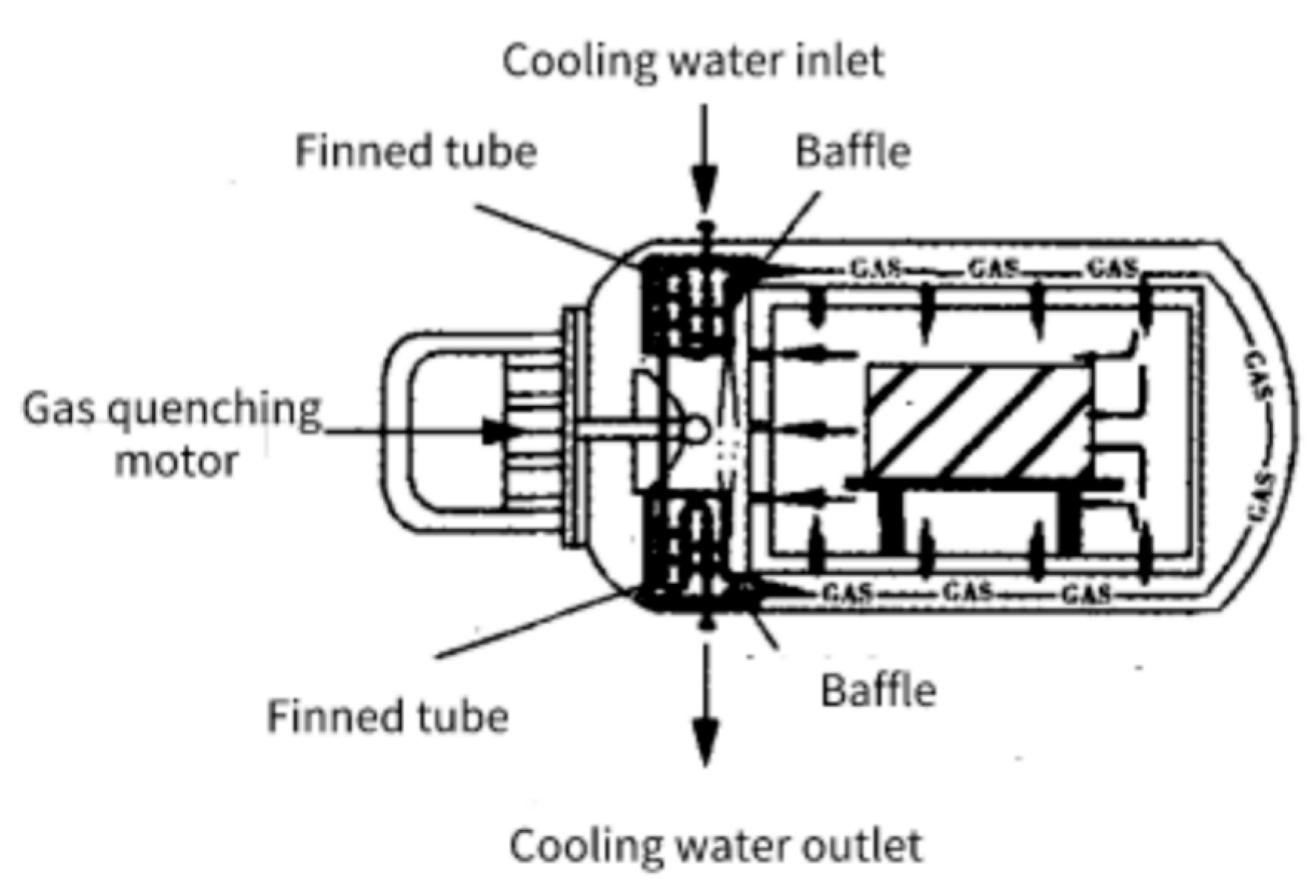
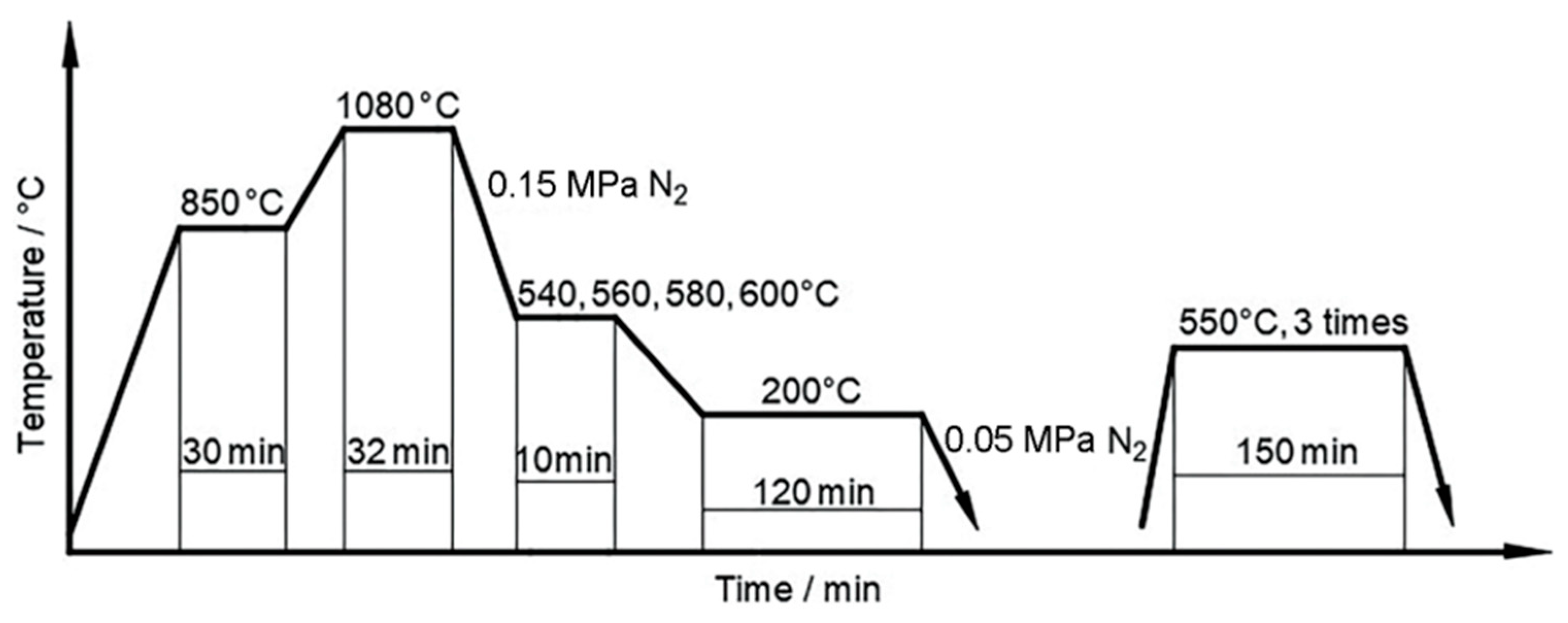

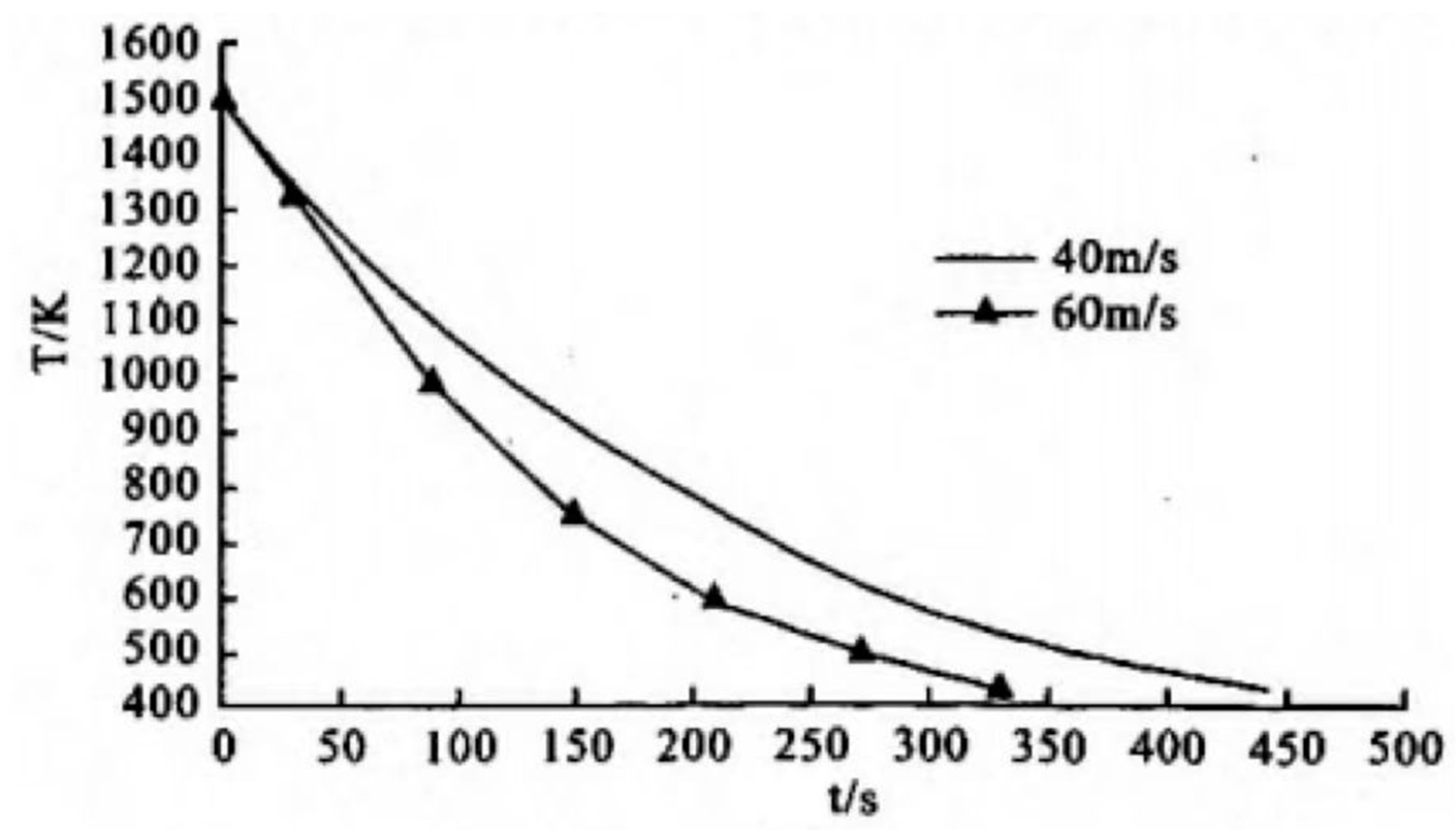


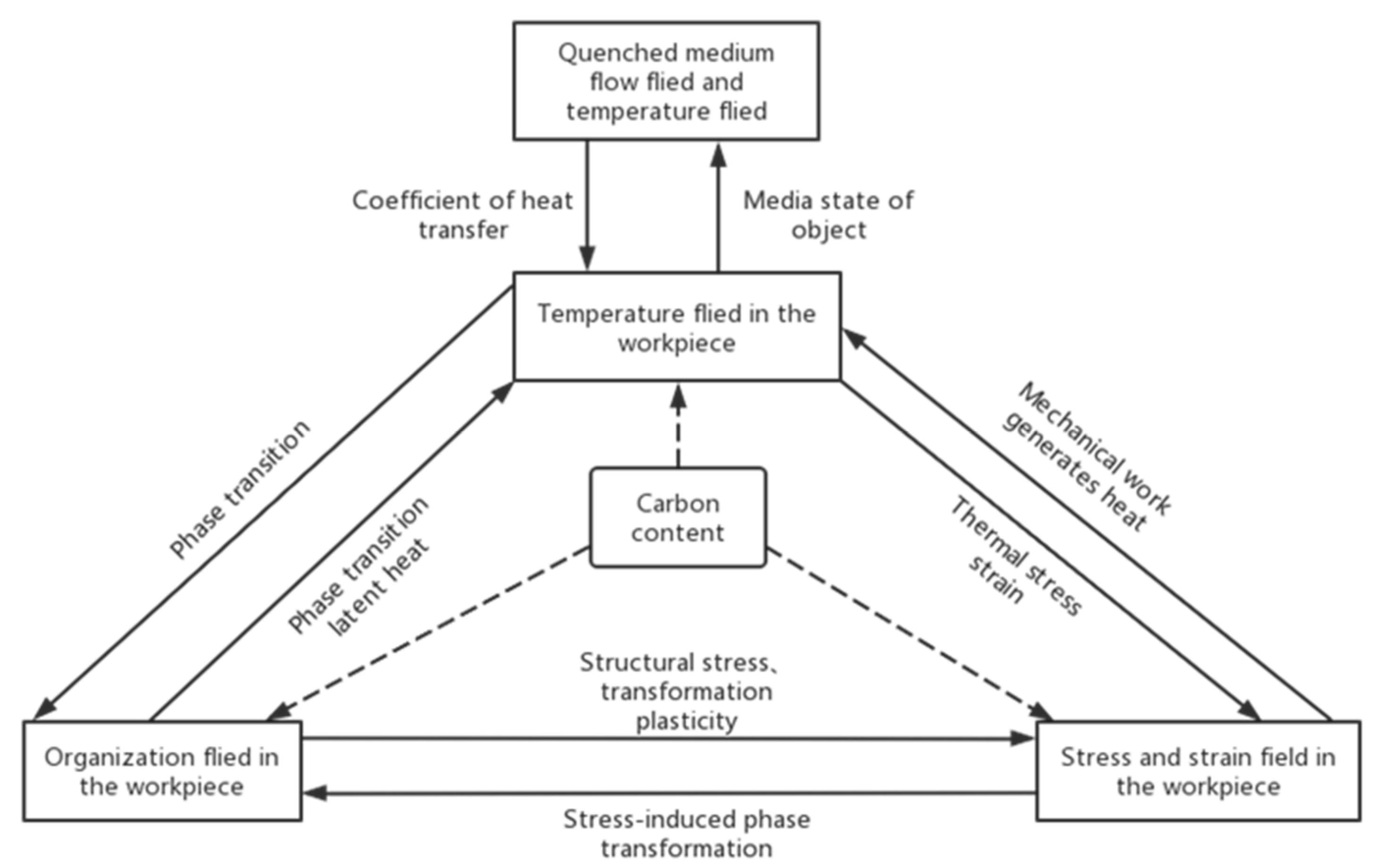
| Time | Development Circumstance | Characteristics |
|---|---|---|
| 1975 | The world’s first vacuum high-pressure gas quenching furnace | Its cooling rate was higher and more uniform than previous gas quenching furnaces. |
| 1980 | NVFC series high-pressure vacuum heat treatment furnace | Quenching at 1.7 atmospheres had enough cooling speed to enable workpieces to meet the hardness requirements. |
| 1981 | Introduced and installed one ZC-30 and one ZC-65 vacuum quenching furnace and one ZCT-65 vacuum carburizing furnace. | Increased the workpiece life by more than one time, and even tens of times, compared with salt bath heat treatment. |
| 1983 | China’s first pressurized vacuum gas quenching furnace | Improving the cooling capacity of the domestic vacuum gas quenching furnace. |
| 1988 | 0.5 MPa gas quenching vacuum furnace (VDN-513R) | a single-chamber horizontal internal circulation cooling gas quenching furnace, and the gas cooling pressure could be selected within the range of 0.2 MPa to 0.5 MPa. |
| China’s first high-pressure vacuum gas quenching furnace | Capable of being pressurized to 0.5 MPa. | |
| The end of the 20th century | Vacuum gas quenching furnaces of 0.2, 0.6, 0.8, 1, and 2 MPa | With vertical and horizontal types. |
| Two-chamber vacuum furnaces called DualTherm | Compared to single-chamber vacuum furnaces, the double-chamber vacuum furnace has better cooling capacity, and the cooling effect of the 0.2 MPa N2-cooled double chamber furnace is equivalent to that of the 0.4 MPa single chamber furnace. | |
| 5 MPa gas quenching vacuum furnaces | Not only share the advantages of ordinary vacuum gas furnaces (good surface brightness of heat-treated products, small distortion, and no secondary cleaning), but also greatly expand the range of materials and section size of treated workpieces. | |
| 2001 | A modular system of the ModulTherm | The system is extremely flexible. Each processing room can be operated independently, allowing individual processing rooms requiring maintenance to be closed separately, while the other processing rooms operate normally. |
| 2013 | HZQL-450 vertical gas quenching vacuum furnace with 1 MPa high-pressure and high flow rate | Increase the loading capacity to 2500 kg. |
| Steel Grade | Heat Treatment Method | Achieving Results |
|---|---|---|
| 30CrMnSiNi2A | Vacuum quenching | No oxidation or decarburization on the surface. |
| 8Cr4Mo4V | Vacuum step quenching and tempering process | Toughness is increased by 23.3%, and the rotating bending fatigue limit is increased by 110 MPa. |
| Cr12MoV | Vacuum gas quenching | A significant improvement in hardness, the surface was clean and neat. |
| W6Mo5Cr4V2 | The hardness value increases with an increase in quenching temperature, reaching a peak at 1220 °C. | |
| 4Cr5MoSiV1 | Excellent mechanical properties, the hardness, structure, and corrosion resistance of the material surface are affected by the quenching speed. | |
| 1Crl7Ni2 | Oil quenching and gas quenching | Gas quenching led to an increase in the tensile strength of 1Crl7Ni2 steel. |
| AISI420 | Laser, vacuum, and induction hardening | Vacuum quenching improved both wear resistance and corrosion resistance. |
Disclaimer/Publisher’s Note: The statements, opinions and data contained in all publications are solely those of the individual author(s) and contributor(s) and not of MDPI and/or the editor(s). MDPI and/or the editor(s) disclaim responsibility for any injury to people or property resulting from any ideas, methods, instructions or products referred to in the content. |
© 2023 by the authors. Licensee MDPI, Basel, Switzerland. This article is an open access article distributed under the terms and conditions of the Creative Commons Attribution (CC BY) license (https://creativecommons.org/licenses/by/4.0/).
Share and Cite
Hu, S.; Zhu, L.; Zhang, M.; Tang, X.; Wang, X. Development and Prospect of Vacuum High-Pressure Gas Quenching Technology. Materials 2023, 16, 7413. https://doi.org/10.3390/ma16237413
Hu S, Zhu L, Zhang M, Tang X, Wang X. Development and Prospect of Vacuum High-Pressure Gas Quenching Technology. Materials. 2023; 16(23):7413. https://doi.org/10.3390/ma16237413
Chicago/Turabian StyleHu, Shengde, Lin Zhu, Mao Zhang, Xuefeng Tang, and Xinyun Wang. 2023. "Development and Prospect of Vacuum High-Pressure Gas Quenching Technology" Materials 16, no. 23: 7413. https://doi.org/10.3390/ma16237413
APA StyleHu, S., Zhu, L., Zhang, M., Tang, X., & Wang, X. (2023). Development and Prospect of Vacuum High-Pressure Gas Quenching Technology. Materials, 16(23), 7413. https://doi.org/10.3390/ma16237413









